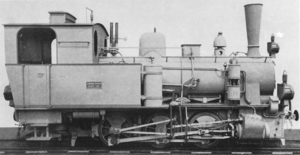TRAVEL 1s to 3s
| TRAVEL 1s to 3s | |
|---|---|
|
Factory photo Borsig
|
|
| Numbering: | TRAVEL 1s to 3s |
| Number: | 3 |
| Manufacturer: |
Borsig serial numbers: 4870–4872 |
| Year of construction (s): | 1901 |
| Retirement: | until 1956 |
| Type : | C n2t |
| Gauge : | 1000 mm ( meter gauge ) |
| Length over buffers: | 7,470 mm |
| Height: | 3,700 mm |
| Width: | 2,300 mm |
| Total wheelbase: | 2,250 mm |
| Empty mass: | 22 t |
| Service mass with tender: | 28.5 t |
| Friction mass: | 28.5 t |
| Wheel set mass : | 9.5 t |
| Top speed: | 35 km / h |
| Indexed performance : | 220.8 kW (300 PS) |
| Wheel diameter: | 920 mm |
| Control type : | Allan control |
| HD cylinder diameter: | 340 mm |
| Piston stroke: | 500 mm |
| Boiler overpressure: | 12 bar |
| Number of heating pipes: | 118 |
| Grate area: | 1.02 m² |
| Evaporation heating surface: | 47.6 m² |
| Water supply: | 3 m³ |
| Fuel supply: | 1.2 t |
| Brake: |
Westinghouse brake handbrake |
| Coupling type: | Balance lever coupling |
The steam locomotives WEG 1s to 3s were meter - gauge, three - axle tank locomotives that were built by Borsig for the Württembergische Eisenbahn-Gesellschaft and were used on the Amstetten – Laichingen line. The locomotives were in use on the line until 1956. The WEG 2s is now at the Ulm Railway Society after 25 years as plinthed for operative work-up for the museum traffic between Amstetten and Oppingen provided.
History and commitment
prehistory
In 1899, the Württembergische Eisenbahn-Gesellschaft ordered four triple-coupled locomotives from Borsig for its two meter- gauge routes, Amstetten – Laichingen and Gaildorf – Untergröningen .
Since the WEG decided when the locomotives were being built to run their route to Untergröningen in standard gauge , they only took over three locomotives for the route to Laichingen. The fourth locomotive ordered was taken over by the Königlich Württembergische Staats-Eisenbahnen , which urgently needed locomotives for its Nagold – Altensteig route and was named KWSt.E. Ts3 began. The locomotive was in operation until 1928.
Amstetten – Laichingen railway line
The locomotives for the WEG were named WEG 1s to 3s and carried out passenger and freight train services. To do this, they were equipped with a Westinghouse brake , and the trolleys were connected with a coupling rod to move the freight trains .
From 1956 they were replaced by railcars. The locomotives 1s and 3s were dismantled, whereby a snow plow was built from the chassis of the 3s , the locomotive 2s remained. Originally an installation in the local history museum in Laichingen was planned, which could not be realized due to the dimensions. Therefore it was erected as a memorial in Laichingen from 1964. She stood there for about 13 years. Since her condition was constantly deteriorating, she was handed over to the Marxzell Vehicle Museum in 1977 , where she could not be sheltered from the weather. In 2002 it was transferred to Amstetten with the aim of rebuilding it as a rollable showpiece (2020).
construction
Features of the locomotives were:
- riveted sheet metal frame with water tank in the front area,
- Running gear without compensation with suspension springs above the axle bearings on the first two axles and below the axle bearings on the drive axle,
- riveted long boiler made of two sections with a distance of 2.9 m between the pipe walls, on the first boiler section sat the bell and the rectangular sandpit, on the second boiler section the steam dome,
- rectangular fire box with strongly sloping grate between the frame cheeks,
- Two-cylinder wet steam engine with external horizontally arranged cylinders with Allan control and flat slide valve ,
- single-stage air pump in front of the circulation and one air tank in front of the water tanks on the side,
- Lateral coal box in front of the left half of the driver's cab on the water tank.
literature
- Ludger Kenning: The Amstetten-Laichingen narrow-gauge railway . Verlag Kenning, Nordhorn 2001, ISBN 3-933613-48-5 , p. 50-52 .
Web links
Individual evidence
- ^ A b Ludger Kenning: The Amstetten – Laichingen narrow-gauge railway . Verlag Kenning, Nordhorn 2001, ISBN 3-933613-48-5 , p. 50-52 .
- ↑ Photo of WEG 1s and 3s at eisenbahnstiftung.de
- ↑ Photo of the WEG 2.s as a memorial
- ↑ Website about the WEG 2s at the UEF
